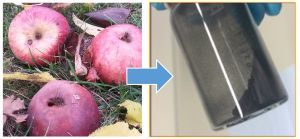Apple-based sustainable batteries

A carbon-based active material produced from apple leftovers and a material of layered oxides might help reduce the costs of future energy storage systems. Both materials were found to have excellent electrochemical properties and enable environmentally compatible and sustainable use of resources.
Sodium-ion batteries are not only far more powerful than nickel-metal hydride or lead acid accumulators, but also represent an alternative to lithium-ion technology, as the materials required to make them are abundant, easily accessible and available at low cost.
Researchers at the Helmholtz Institute of Ulm of Karlsruhe Institute of Technology have made an important step towards the development of active materials for sodium-based energy storage systems. For the negative electrode, the researchers developed a carbon-based material, which can be produced from apple leftovers. The researchers demonstrated more than 1000 charge and discharge cycles of high cyclic stability and high capacity.
The material developed for the positive electrode consists of several layers of sodium oxides. This active material avoids having to use cobalt, the expensive and environmentally hazardous element that is frequently used in active materials of commercial lithium-ion batteries. The new active material, in which electrochemical energy storage proper takes place, reached the same efficiency, cyclic stability, capacity and voltage without any cobalt under laboratory conditions.
Both materials mark an important step towards the development of inexpensive and environmentally friendly sodium-ion batteries, according to researchers.
Computational model enhances battery safety
Researchers have developed a new computational model that offers insights into one of the key...
Novel method to extend lifecycle of Li-ion batteries
Researchers have uncovered a hidden surface degradation mechanism in the cathodes of lithium-ion...
Sensor could help prevent Li-ion battery fires
Researchers have developed new technology to detect dangerous gas leaks in lithium-ion batteries,...





